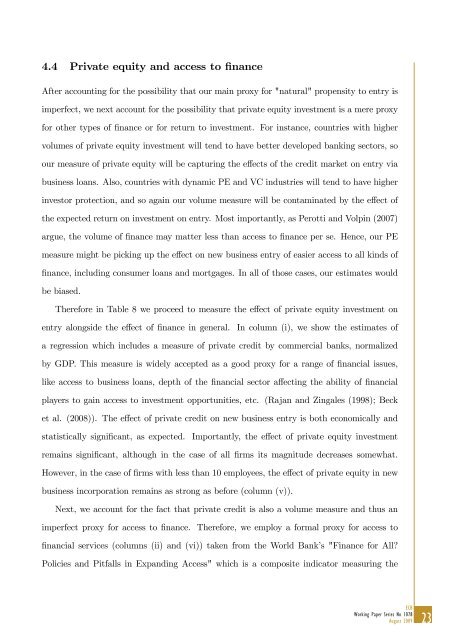On the real effects of private equity investment: evidence from new ...
On the real effects of private equity investment: evidence from new ...
On the real effects of private equity investment: evidence from new ...
- No tags were found...
You also want an ePaper? Increase the reach of your titles
YUMPU automatically turns print PDFs into web optimized ePapers that Google loves.
4.4 Private <strong>equity</strong> and access to …nanceAfter accounting for <strong>the</strong> possibility that our main proxy for "natural" propensity to entry isimperfect, we next account for <strong>the</strong> possibility that <strong>private</strong> <strong>equity</strong> <strong>investment</strong> is a mere proxyfor o<strong>the</strong>r types <strong>of</strong> …nance or for return to <strong>investment</strong>. For instance, countries with highervolumes <strong>of</strong> <strong>private</strong> <strong>equity</strong> <strong>investment</strong> will tend to have better developed banking sectors, soour measure <strong>of</strong> <strong>private</strong> <strong>equity</strong> will be capturing <strong>the</strong> e¤ects <strong>of</strong> <strong>the</strong> credit market on entry viabusiness loans. Also, countries with dynamic PE and VC industries will tend to have higherinvestor protection, and so again our volume measure will be contaminated by <strong>the</strong> e¤ect <strong>of</strong><strong>the</strong> expected return on <strong>investment</strong> on entry. Most importantly, as Perotti and Volpin (2007)argue, <strong>the</strong> volume <strong>of</strong> …nance may matter less than access to …nance per se. Hence, our PEmeasure might be picking up <strong>the</strong> e¤ect on <strong>new</strong> business entry <strong>of</strong> easier access to all kinds <strong>of</strong>…nance, including consumer loans and mortgages. In all <strong>of</strong> those cases, our estimates wouldbe biased.Therefore in Table 8 we proceed to measure <strong>the</strong> e¤ect <strong>of</strong> <strong>private</strong> <strong>equity</strong> <strong>investment</strong> onentry alongside <strong>the</strong> e¤ect <strong>of</strong> …nance in general. In column (i), we show <strong>the</strong> estimates <strong>of</strong>a regression which includes a measure <strong>of</strong> <strong>private</strong> credit by commercial banks, normalizedby GDP. This measure is widely accepted as a good proxy for a range <strong>of</strong> …nancial issues,like access to business loans, depth <strong>of</strong> <strong>the</strong> …nancial sector a¤ecting <strong>the</strong> ability <strong>of</strong> …nancialplayers to gain access to <strong>investment</strong> opportunities, etc. (Rajan and Zingales (1998); Becket al. (2008)). The e¤ect <strong>of</strong> <strong>private</strong> credit on <strong>new</strong> business entry is both economically andstatistically signi…cant, as expected.Importantly, <strong>the</strong> e¤ect <strong>of</strong> <strong>private</strong> <strong>equity</strong> <strong>investment</strong>remains signi…cant, although in <strong>the</strong> case <strong>of</strong> all …rms its magnitude decreases somewhat.However, in <strong>the</strong> case <strong>of</strong> …rms with less than 10 employees, <strong>the</strong> e¤ect <strong>of</strong> <strong>private</strong> <strong>equity</strong> in <strong>new</strong>business incorporation remains as strong as before (column (v)).Next, we account for <strong>the</strong> fact that <strong>private</strong> credit is also a volume measure and thus animperfect proxy for access to …nance. Therefore, we employ a formal proxy for access to…nancial services (columns (ii) and (vi)) taken <strong>from</strong> <strong>the</strong> World Bank’s "Finance for All?Policies and Pitfalls in Expanding Access" which is a composite indicator measuring <strong>the</strong>ECBWorking Paper Series No 1078August 200923















